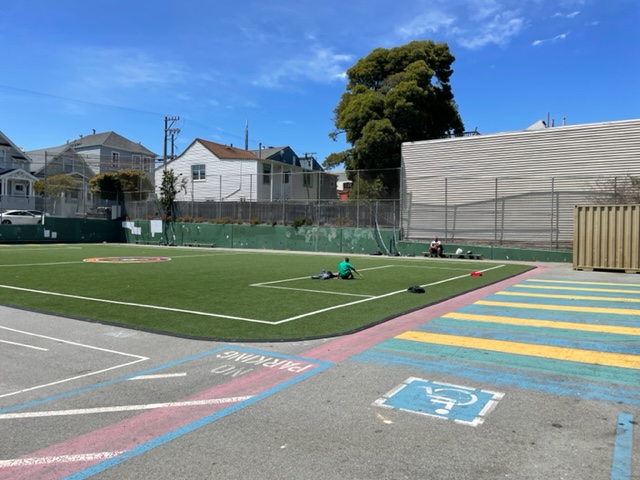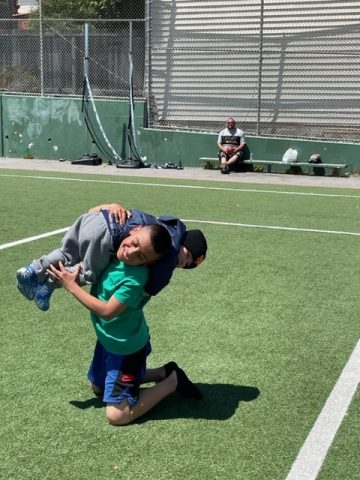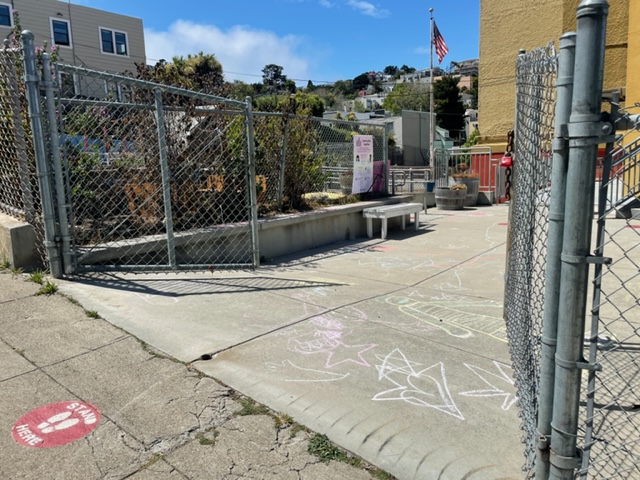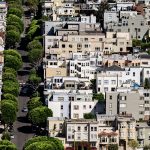
On a bright Saturday afternoon in San Francisco’s Bernal Heights neighborhood, Will Portillo grabbed a soccer ball and his kids, Moses, 10, and Michael, 2, and walked them one block to Paul Revere Elementary School, where Moses is finishing up 4th grade.
“I saw it was open, so I came in here,” says Portillo, who often works weekends at a tire repair shop and appreciates the opportunity to play with his sons nearby. “I like it when the school is open. It’s very easy for me.”
The gate at Paul Revere Elementary School is open on weekends thanks to San Francisco Unified School District’s Shared Schoolyards Program, which currently provides public access to about 50 of the city’s 70 schoolyards on weekends. The district’s custodial department unlocks gates in the morning and relocks them at the end of the day, and park stewards circulate among open schools to keep an eye on things.
“My role is to make sure everyone is safe,” says Adrian Angulo, who is monitoring Willie L. Brown Jr. Middle School in the Silver Terrace neighborhood. “We’re checking to make sure that no adults come into the schoolyard without children, or that people don’t come in with dogs. This is not a dog park — it’s a community place.”
Around the Bay Area, cities, school districts, and communities are opening up to the possibilities of activating school grounds to serve as public assets, especially in urban areas where access to public open space is often limited and distributed inequitably.
“Schools are by their very nature spread relatively evenly throughout a community,” says Amanda Brown-Stevens, executive director of Greenbelt Alliance. “This means that even cities with a wide disparity of park access in different neighborhoods can help reverse that trend by opening up green and well-maintained schoolyards to the broader community.”
Parks Within Walking Distance for All

According to the Trust for Public Land, 100 million people — including 28 million children — don’t have access to a park within a 10-minute walk of home. In large cities, communities of color have access to 44% less park space than majority-white communities. In the Bay Area, about half of children 15 or younger do not have a public park within walking distance.
“We see schoolyards as an integral part of our 10-minute walk goal,” says Kira Maritano, senior project manager of the Trust for Public Land’s Bay Area Parks for People initiative. “We see them as an amazing way to unlock millions of acres across the country.”
California has about 130,000 acres of public school land for K–12 students, and more than 6 million of the state’s students and school employees visit a schoolyard every day, says Sharon Gamson Danks, CEO and founder of Green Schoolyards America. “That’s a million more people than visit Yosemite in an entire year.”
Interest in “greening” school grounds — by transforming them from vast seas of asphalt into more natural spaces with gardens, grass, trees, and creeks for education and play — bloomed during the pandemic, Danks says. “School districts are realizing the multitude of benefits that come with a greener schoolyard for children, families, public health, and, in turn, the environment.”

Relieving the Pressures of Lockdown
San Francisco’s Shared Schoolyard Program got its start a decade ago, when then–city supervisor Mike Farrell was looking for a safe, flat place to teach his kids to ride bikes and found the local schoolyard closed. He reactivated a dormant pilot program to open the city’s school grounds on weekends.
Yelena Miakinina, manager of San Francisco’s Shared Schoolyards program, says that before the pandemic almost every schoolyard in the city was open on weekends, amounting to some 36 acres of additional open space for public use by San Francisco families.
When San Francisco schools were closed in early 2020, the school grounds were too. As the pandemic wore on, SFUSD began gradually reopening schoolyards to help families relieve the pressures of lockdown. “There were so many families with kids who had to spend 8 hours a day in front of the computer, and they finally had the opportunity to go to the schoolyards and play safely,” Miakinina says.
The program is now providing free weekend classes to medium- and low-income families, including soccer, music, art, and bike safety, and a bookmobile makes the rounds. About 2,600 children participated in free programming during the 2022 school year, double that of 2 years ago.

Greening Schoolyards
Across the Bay in Oakland, voters passed Measure Y in November 2020 that provides $735 million in school upgrades and repairs, including $200 million for initiatives such as converting asphalt schoolyards into green play spaces.
The Trust for Public Land’s Community Schoolyards program has been working with Oakland to make schoolyards in disadvantaged neighborhoods more green and kid-friendly, with the hope of eventually opening them up to the surrounding community on weekends.
At Melrose Leadership Academy in East Oakland, for example, a community visioning process is leading to the replacement of 4,000 square feet of asphalt with gardens, fruit trees, outdoor classrooms, vegetated swales, nature play areas, a turf field, and shade trees.
“We are working toward a living schoolyard — a schoolyard that is serving the community, and one that is more than just a slab of asphalt,” The Trust for Public Land’s Maritano says.
Photos by Janet Byron

